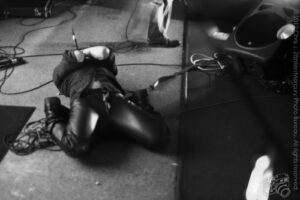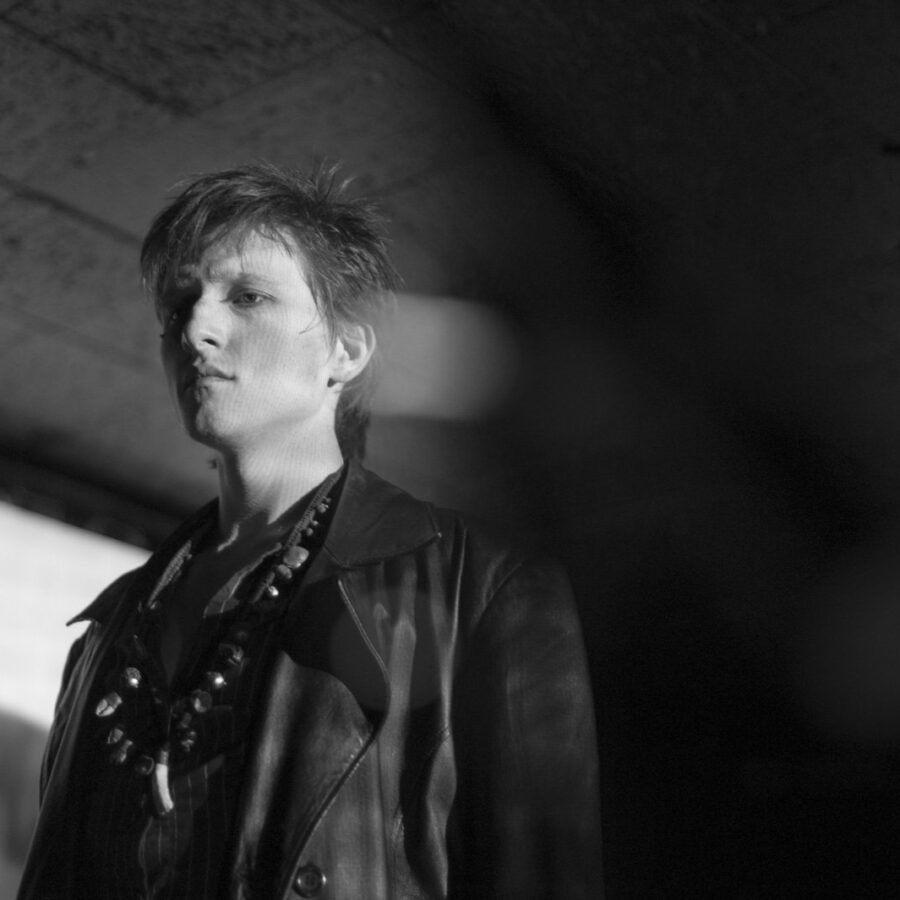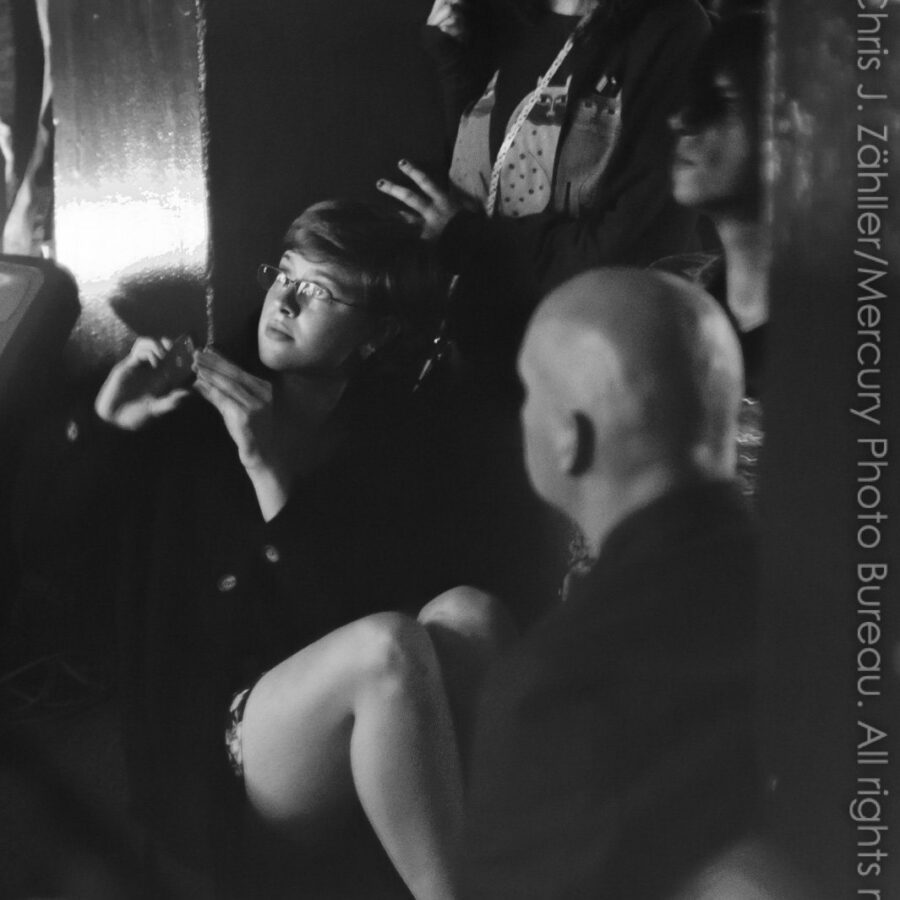
David Goad (Kali Ra) Interview & Gallery, Pt. 1
The Interview, Pt. 1
David Goad (Kali Ra) Interview, Pt. 1
David Goad, frontman for Kali Ra and various other musical and performance projects, recently sat down with us to answer some questions. His lovely wife, Alicia, was on hand to call his bullsh*t supplement his answers and fact-check. She also told us 10 Things You Didn’t Know about David Goad, which you can read in Part 2 of the interview.
Mercury Photo BureauI understand you’re a graduate of ACM. When did you graduate?
David Goad[Looks at watch] Let’s see … I graduated in 2011.
MPBWere you a composition major?
DavidI was a guitar performance major. [I took composition classes at] ACM and OCCC […]
Mercury Photo BureauWere you involved in musical theatre?
DavidNo, [my area of study] was musical pedagogy; I mostly studied classical guitar, classical voice and composition theory.

MPBYou’ve had a couple of your compositions used in theatre and television.
DavidI had a piece used on [nationally syndicated PBS show] Two Wheel Oklahoma, and I’ve also written a [30 minute] score for a [90 minute] theatre piece called Fubar[, produced at UCO in 2011].
For the PBS show, the producers wanted music that was [both] driving and ambient; I can do both of those things. The piece is called called Aphasia and it’s a meditation on a pentatonic scale [Sidenote: A musical scale with 5 notes per octave. Scales in modern Western music typically employ a heptatonic (7 note) scale.] — for the 1st half of the piece — and then you have a lot of ‘roboto’ rhythm, and there are bridges with a lot of sharp punctuations. The instrumentation is a lot of tympani and a lot of percussion like vibraphone and marimba. But I wrote the melody for guitar with a “sustainer” pickup [Sidenote: Sustainers consist of a device to generate a magnetic field that causes the strings to vibrate, coupled with a pickup to “pick up” and amplify the sound, thus creating near-infinite sustain.] , allowing the performer to play without picking notes [with the right hand]; you hold the strings to the frets [with your left hand] […] [so you can play the guitar like a violin].
It’s a densely harmonic piece; in the 2nd part, it’s a 12/8 rhythm; it’s bouncier with a funky bass line that’s static through the whole thing. Then it becomes natural minor and carries it all the way to the end, where it ends on the tonic, [on a major chord].
[The music for] Fubar was a lot less consonant. It was mostly incidental music. I used a lot of 12-tone and atonal techniques, with a lot of minor 2nds. I was trying to develop a sonic ambiance based on sympathetic vibration, rather than a cohesive harmony or melody, vibrations that would stretch or pulsate rapidly.
[The theatrical piece] Fubar was experimental, like Antonin Artaud’s Theatre of Cruelty. [Sidenote: Artaud theorized the surrealist theatrical form “Théâtre de la Cruauté” in his essay collection The Theatre and its Double, published 1938.] So, obviously, I wanted to compose something ‘deconstructionist,’ taking a very non-musical approach to music. [Conversely,] I would ‘give the audience a bone’ here and there. I created some very ‘robotic’ dance pieces driven by distorted bass and drums. It’s sort of […] Brian Eno meets Trent Reznor meets John Cage […].
Mercury Photo BureauTell us about your pre-Kali Ra projects, and also your current side projects.
DavidBefore Kali Ra, I was in Of the Tower. I don’t want to say we were […] a cliché Goth band, but we were more Goth than Kali Ra.
Of the Tower consisted of Todd Plunkett, Nathan Stein Steinman and me. In the ’90s and the early ’00s, [Todd and Nathan] were part of the Oklahoma rock scene. Nathan was in The Venditos and Todd was in Kite Flying Robot and Ghosts of Monkshood, and he was also in Shiny Toy Guns for a bit. He was everywhere.
We were trying to approach the band as an art collective, and we had very high aspirations for it, but it just never happened […]. Musically, we all had similar influences, and we wanted to cram them together to make delicious jam out of it. We were all fans of Bauhaus and The Doors and David Bowie and Joy Division and Philip Glass. We wanted to do this minimalist post-punk thing that was dark and Goth-y.
I took my guitar approach and my singing from Daniel Ash and Peter Murphy, and Todd did a lot of Joy Division-New Order stuff, and like, [John] Densmore from The Doors; very expressive, angular drumming; it was almost jazzy. Nathan was heavily into world music: klezmer and Gypsy music and Philip Glass. You’d think a mixture of all 3 of them [would work]. It was much more difficult in reality to effectively meld them together […].

Alicia GoadI really don’t think that [how they collaborated] was what broke [Of the Tower] up. I think it was more [a matter] of them not coming to practice and not wanting to move on and tour. It wasn’t because of creative differences.
DavidI will admit, I was being diplomatic. It was my aspiration to tour and produce albums […] and now that Of the Tower was disbanded, I had tabula rasa to be able to hone in on the songwriting craft, to not be sticking to a pastiche and [to] write the best songs that I could. [Being] in a band for so many years, that had almost been credible, you know, it was a good learning [experience]. So now I had this ability to write baroque, pop-rock-electro-glam-industrial infused songs. Kali Ra is the next step, creatively, and is also my flagship project.
I now have [many excellent musicians at my disposal]. Justin Hogan won the 2002 Best Guitarist Oklahoma Rock Award […]. Joel Price, another friend and colleague, is an excellent producer; his production style is like Brian Eno’s. [He thinks in terms of] soundscapes, to create music as a painting […].
MPBLet me sidetrack you with a question I recently asked Peelander Yellow. Brian Eno once wrote an essay in which he posited that recent advances in recording technology rob music making of intimacy and immediacy, replacing what were once 1-to-1 correspondences between action and result (‘analogue’) with multi-step abstractions that require the assistance of a software engineer for even the simplest task (‘digital’). What technology do you employ when recording, and has this been a problem for you?
DavidRight now, we’re using the washing machine, the CD rack, and, um, rooms; we’re very heavy into using rooms, along with all the digital stuff. [laughter]
My point is, we try to meld the 2 together and try not to rely too heavily [on either analog or digital]. That’s where Joel excels; he and I do a lot of experimentation with timbre, pitch, and sonic depth, things that were commonplace in industrial and electronic music at its inception, but are now passé [as musicians increasingly rely on VST plugins]. [Sidenote: Virtual Studio Technology is an interface for integrating software audio synthesizer & effect plugins with audio editors & hard-disk recording systems, often used to emulate analogue and spatial effects. It is analogous to “Photoshop actions” or “Lightroom filters” in digital photography.] By the way, Joel is also Kali Ra’s other guitarist; his style is similar to Robert Fripp’s or The Edge’s.
[We] who have an artistic approach [to music] still cling to immediacy, [like the Actionist manifesto]; [Sidenote: Viennese Actionism (circa 1960 – 1971) rejected object-based or otherwise commodifiable art practices by staging precisely scored “Actions” in controlled environments or before audiences. Some art historians see it as the forerunner to performance art.] you are trying to create an event, and I think that is what a recording is: you are trying to [capture that event].

Mercury Photo BureauSomething that really happened, not something that only occurred in the digital domain.
DavidRight. You could spend a year recording and mixing an EP that is digitally perfect, but it wouldn’t have the love, the care, the attention, or the rawness of the experimental stuff from the ’70s and the early ’80s. You have Einstürzende Neubauten, you have David Bowie’s Berlin Trilogy; that was a time when people were still discovering how to do these things.
These tools shouldn’t be used as a crutch. We have to be inventive beyond them; we’ve got to define new standards. [Sidenote: At this point, David speaks at length about process. For brevity, we’ve omitted his discourse.]
Mercury Photo BureauThose are all valid concerns, but I’m hearing a lot about process and almost no mention of music. Are you a musician, or are you an artist who may include music in his art, but that’s only part of what you do?
DavidYes [, the latter]. But the entire thing is a process from end to end. You’re a parent: you conceive the child, that is, the music, you compose and go through several drafts, you’ve birthed the child, you’re rehearsing the music, and then there’re still some tweaks needed before you finally release it into the wild.
He’s Irish
David’s ancestors are Irish, with the attendant ‘gift of the gab.’ As he had no shortage of words, I’m breaking this interview into 2 parts. Part 2 includes streaming audio for his song, Electric Living. Also in part 2 are 10 Things You Didn’t Know about David Goad, as told by Alicia Goad.
Gallery
Gallery: Kali Ra at the HiLo Club

























